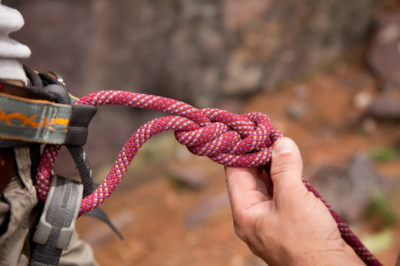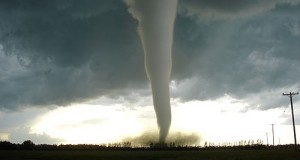1. Square Knot
This is a pretty basic knot that you will use often and for many different tasks. A square knot is used to attach two ropes together. It’s made by tying two overhand knots using the two ends of the different ropes. Remember to tie it right over left, and then left over right. Square knots are useful because you won’t always have a long rope when you need one. More often, people have small lengths of rope because they’re easy to store and because you need ropes of different lengths to use for different activities.
The downside of square knots is that they only work with ropes of equal thickness and of the same material. If you don’t use ropes of equal thickness or of the same material, then the rope will slip. Square knots have also been used for a long time in first aid because the knot is flat.
Story continues below video
2. Clove Hitch
If you need to lash together a shelter, a clove hitch knot is what you want. The word clove comes from the root word cleave, so this knot is for anything that you need to cleave together. It’s tied directly around a pole or log in order to lash it to something else; it’s usually tied in the middle of the rope because this knot is best when there’s tension coming from both sides of the rope. It holds tightly and usually doesn’t slip or get loose, through constant wear and movement can make it loosen a bit. This knot is considered one of the most important knots next to a bowline and a sheet bend knot. A clove hitch is also a climbing knot. If you find yourself in a situation where you have to climb up or down something, this is the simplest knot you can use as an anchor. The knot is easy to tie and untie, and you can also lengthen or shorten the tie point without having to untie the whole knot. There are disadvantages of using a clove hitch as well. Since it’s such a simple knot, it isn’t as strong as other more advanced anchor knots, and the knot can slip if it’s not properly tightened after tying. The knot also loses some of its effectiveness if the rope is wet or frozen.
Story continues below video
3. Bowline Knot
This is another very important knot and combines the effectiveness of a square knot and a clove hitch. It’s similar to a square knot in that you can use it for many different activities, and it’s an all-purpose camping knot. It’s similar to a clove hitch in that it’s a climbing knot, but it’s a more advanced knot than a clove hitch. A bowline knot doesn’t slip, even if it’s not tightened all the way. You can use a bowline knot for hanging your food up in a tree to keep it away from predators, and you can also use it in emergency rescues because the knot makes a loop that you can get a leg or arm through. It you need it, a bowline is also valuable for securing animals, such as horses, cattle, and goats. The bowline doesn’t slip or tighten very much, so it’s gentle on the animal’s neck.
Story continues below video
4. Tautline Hitch
This basic camping knot is most useful for tents and lashing things down so that they don’t move. For tents and shelters, this knot is attached to the tent or tarp and then to an anchor in the ground, such as a tent stake or a tree branch. It is an adjustable knot so that every time the rope slackens or the tent moves around, the line can be pulled taut again with just a little adjustment. If you have a survival pack with lots of different gear hanging off that needs to be tied down, a tautline knot can be used, and if your gear shifts or the movement of hiking makes the rope move and slacken, it’s very easy to readjust the line without untying the knot.
Story continues below video
5. Sheet Bend Knot
A bend knot is a class of knots that are used to tie different ropes together, and there are many different forms of bend knots. A sheet bend knot is typically a sailing knot, but it has been widely used by campers, survivalists, and hikers for years. Typically sailors use it with thinner lines and use it to make netting. This knot is a more advanced form of the square knot and is used for tying two rope ends together. This time, you can tie two different ropes together despite varying thickness and rope material. To make it even more secure, you can do a double sheet bend knot.
Story continues below video
What Types Of Situations Use These Knots?
Now that you know a few camping and survivalist knots, what are some situations where you might use one or several of them? It’s not enough to know how to identify and make different types of knots; you must also be proficient in knowing what types of knots are suitable for different survival situations as well.
Building A Shelter
If you’re in a survival situation, you know that the first thing to do is to scout out a good location to make a shelter. Once you find your location and gather all the materials, you need to start building, but how are you going to put it together? Some shelters rely on balance alone to keep them together, but if you have rope available, you should use it to lash together your shelter so that it’s stronger. Depending on the shelter you build, you will likely need a tautline and a clove hitch knot. The clove hitch is used to lash poles together, and a tautline is used to lash a tarp to the ground.
Rock And Tree Climbing
Sometimes it becomes necessary in survival situations to hastily climb up or down a rock ledge or trees. This could be to avoid predators, to find a way back to a path, or to scout the area. Whatever you have to climb, there are going to be some specific knots you use. The one you’ll use most is a bowline and a clove hitch knot. A clove hitch can be used as an anchor, and the loop in a bowline knot is also useful for hauling gear or people up a tree or steep incline.
Utilizing Resources To Make A Rope
Often when you’re in the wilderness, you aren’t entirely prepared for a survival situation. You might have a coat and a few small survival things you can carry in your pocket or a small bag, but what if you don’t have any rope and need some to make a shelter for the night? Using a square knot or a sheet bend knot, you can take the drawstring out of your coat and the shoelaces from your shoes and connect them together to form a longer piece of cord.
 Off The Grid News Better Ideas For Off The Grid Living
Off The Grid News Better Ideas For Off The Grid Living

 Knot tying might not cross your mind when you’re thinking about skills you would need to survive in the wilderness, but knowing different knots could save your life. Different knots are used in building, setting traps and snares, setting up a fishing line, and climbing. If you don’t use the right knot, you risk having your line or rope come undone, or having to cut your line or rope because the knot won’t come out. Check out some different kinds of knots you might use in different survival situations.
Knot tying might not cross your mind when you’re thinking about skills you would need to survive in the wilderness, but knowing different knots could save your life. Different knots are used in building, setting traps and snares, setting up a fishing line, and climbing. If you don’t use the right knot, you risk having your line or rope come undone, or having to cut your line or rope because the knot won’t come out. Check out some different kinds of knots you might use in different survival situations.


